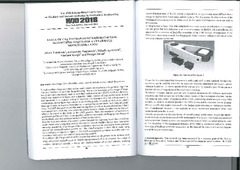Приказ основних података о документу
Usage of CAE environment within control algorithms design for a centrifuge motion simulator
| dc.creator | Vidaković, Jelena | |
| dc.creator | Stepanović, Aleksandar | |
| dc.creator | Lazarević, Mihailo | |
| dc.creator | Kvrgić, Vladimir | |
| dc.creator | Divnić, Danijel | |
| dc.date.accessioned | 2023-02-01T11:46:47Z | |
| dc.date.available | 2023-02-01T11:46:47Z | |
| dc.date.issued | 2018 | |
| dc.identifier.uri | https://machinery.mas.bg.ac.rs/handle/123456789/4133 | |
| dc.description.abstract | Virtual machine design provides various useful means for machines to be produce ‘right the first time’ without the need for physical testing. This is very beneficial to the design of large, heavy and costly machinery such as centrifuge motion simulator (CMS). CMS is a dynamic device that simulates G forces and a dynamic flight conduct of high performance aircraft and spacecraft. It is used for testing of reactions and toler-ance of pilots and astronauts to accelerations above those experienced in the Earth's gravity (G load), as well as for pilot’s trainings in order to improve their abilities to control the aircraft under such difficult conditions. The CMS designed in Lola Institute has the form of a three degree-of-freedom (3DoF) manipulator with rotational axes, where the pilot’s head (or chest), considered to be the end-effector, is placed in the centre of the CMS gondola. From the standpoint of kinematics, predefined profiles of G load in the gondola centre are extremely challenging regarding joint accelerations, and they put huge amount of load on the motors. Benefits from simulations of a control system designed for a process based on a virtual dynamic model prior realization include reduced the overall machine design time, less safety concerns, possibility of re-design of the mechanical structure in accordance to the performance of the proposed control systems etc. The virtual structure of the CMS is made using Catia software, as shown in figure 1. The CMS is a complex geometry assembly and contains three links: main arm and roll ring carrying gondola. If significant flexible properties of the mechanical structure are present in the system, modeling and control methodologies of flexible manipulators have to be adopted. As a result of complex dynamical models, a design and implementation of control schemes realizing standard motion tasks of flexible robots is expected to be significantly more difficult than a design of rigid models-based robot control systems. For this reason, flexible features of the mechanical structure have to be determined. In this study CAE-based methods are used in this purpose. In the presence of long links, link compliance is a major source of deflections in ma-nipulator, and given that link deflection is an inherent property of flexible link manipu-lators, the argument for assessment of flexibility properties of the CMS through deter-mination of the CMS arm deflections is used. For this purpose, finite elements method (FEM) based simulations in Catia are performed. Given that it is determined that the system is sufficiently stiff, control methods for rigid manipulators can be used for the CMS. In order not to excite unmodeled resonances, special attention is paid to: 1) critical speeds of the manipulator; 2) controller gain limitation as a function of natural frequencies of the mechanical structure. CAE tech-nology is used in this purpose also. Developed trajectory planner enabled joint veloci-ties simulations for different application programs, and their comparison with the criti-cal speeds of the mechanical structure. For the low damping case, natural frequencies of the CMS, obtained by modal analysis using FEM in Catia, are adopted as critical speeds of the CMS. Given that the obtained natural frequencies are significantly higher than the highest joint velocities, the unbalance distribution of mechanical structure is not expected to excite mechanical resonances when rigid model-based controller is used. From the perspective of the complexity of control system, performance of dynamic model-based methods has to be compared with performance of a simpler traditional decentralized servo-controller. Control systems are considered for process based on virtual dynamic model. The flexibility of the mechanical structure of the CMS is con-sidered indirectly, within limitation of feedback controller parameters on the basis of the determined natural frequencies of the unconstrained links. | sr |
| dc.language.iso | en | sr |
| dc.publisher | Novi Sad : Univerzitet u Novom Sadu, Fakultet tehnickih nauka | sr |
| dc.relation | info:eu-repo/grantAgreement/MESTD/Technological Development (TD or TR)/35006/RS// | sr |
| dc.relation | info:eu-repo/grantAgreement/MESTD/Technological Development (TD or TR)/35023/RS// | sr |
| dc.rights | openAccess | sr |
| dc.rights.uri | https://creativecommons.org/share-your-work/public-domain/cc0/ | |
| dc.source | Book of abstracts : The 10th International Symposium on Machine and Industrial Design in Mechanical Engineering-KOD 2018, Novi Sad, 6-8 june | sr |
| dc.subject | flight simulators | sr |
| dc.subject | centrifuge | sr |
| dc.subject | CAE | sr |
| dc.subject | flexibility | sr |
| dc.subject | robot control | sr |
| dc.title | Usage of CAE environment within control algorithms design for a centrifuge motion simulator | sr |
| dc.type | conferenceObject | sr |
| dc.rights.license | BY-NC-ND | sr |
| dc.citation.epage | 81 | |
| dc.citation.rank | M34 | |
| dc.citation.spage | 80 | |
| dc.identifier.fulltext | http://machinery.mas.bg.ac.rs/bitstream/id/9664/bitstream_9664.pdf | |
| dc.identifier.rcub | https://hdl.handle.net/21.15107/rcub_machinery_4133 | |
| dc.type.version | publishedVersion | sr |


